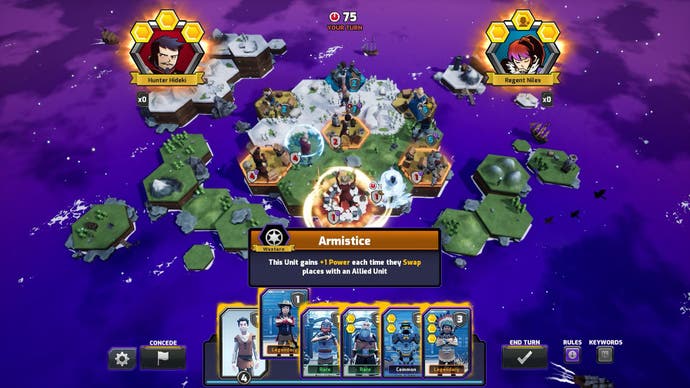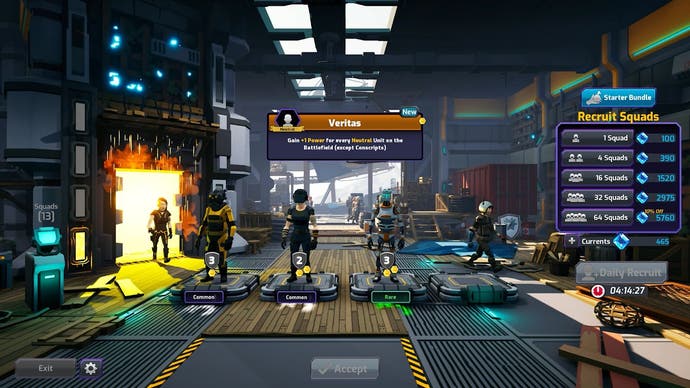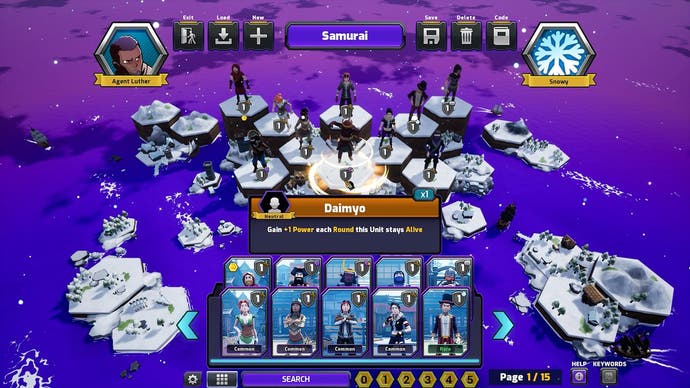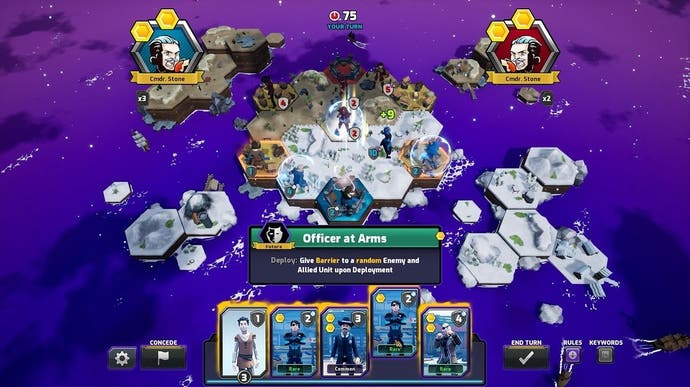Castlehold is a fittingly inventive take on strategy from the Scribblenauts creators
Fort it was very good.
5th Cell, the developer of handheld curio Scribblenauts, has announced its new game today, called Castlehold. It's a card-based tactics game - which is a bit of a surprise, given the sharp left turn from Scribblenauts. And it's also very good, from the brief bit of it that I've played - which, hands up, was maybe a bit of a surprise to me too.
It's out today in early access on Steam, it's free-to-play with optional microtransactions, and it does suffer from a bad case of fonts. And if we're being brutal, there is a touch of the less-fashionable mobile game to it all, too, thanks to a mish-mash of styles and familiarly broad-sweeping army types like 'medieval' and 'western'. But! It is good, and I am a snob, so we'll just skip past the aesthetics here and get to the meat of it.
Castlehold is played on a symmetrical island map, made of exactly 19 hexagonal tiles. Like a Hearthstone or a Magic the Gathering or any other card battler, you play one-on-one, against another human or the AI, bringing your custom-built or preset deck of characters that form your army and playing them onto the map turn-by-turn. The goal is tactical, or strategic maybe, in that you have to get a unit of yours from your castle, the tile nearest to you where they spawn, to your opponent's castle at the map's opposite end, while they of course are trying to do the same.
The spin here is a very clever, dynamic resource system. Between the two opposing castles are five, set-position settlements. Placing a unit on a settlement makes it yours, granting you one gold. Leave it blank or get booted off and your gold goes back down. Different units have different gold costs that need to be met for them to be played, but also some smartly intertwining buffs and debuffs, too, and the sum total of it all is a quite extraordinary amount of depth for a game - a map - of such small size.

Some of this unfolds in the deck-building, wherein you'll have the most luck building an army around a specific style. For some it's about brute force, getting one very strong unit buffed up with extra power and marching it straight down the middle of the map to the enemy base - provided you can set it up with those buffs in time. Others it's about stalling, sending high-power enemy cards back into the player's hand. Others it's speed, with units that have twice the movement distance, but less power, quickly claiming land.
Again, on the surface this doesn't seem that sophisticated but it is, when put into action, with a surprising amount of push-and-pull to the rounds. There's always a threat of one side snowballing and just running away with it, but it never quite happens - a result, I think, of the purposefully odd-numbered map design, where a push in one place always leaves you exposed in another. Characters battle each other in a very simple "biggest number wins" manner, with no lasting damage and so on, and so the strategy comes in your positioning and turn order, and also your mastery of timing buffs and debuffs, piling strength onto that one tank or outpacing it in a down-to-the-wire race to the finish which Jeremiah Slaczka, 5th Cell's co-founder, told me happens surprisingly often.

He also added a little more detail on the free-to-play side of things, anticipating the usual reactions there, emphasising the goal of making them "fair" and, on first impressions, seemingly doing so. Microtransactions are all on the deck-building side of things, with a single currency that can be either earned in-game - just by playing, not requiring you to keep going until you get a certain number of wins, like Hearthstone - or by opting to pay real money. This then gets spent on either loot box equivalents, containing characters for your deck that you can also re-roll, to help stave off some random-chance frustration, plus a couple of daily offers on specific characters that you can buy outright for a discounted price.
This brings Castlehold back to that original point of first impressions, really. The real effect of a somewhat overfamiliar style is that there isn't the same tactile collectability to the cards as there is with other battlers - which is in one sense an improvement, taking away any risk of compulsion to actually spend money on new pieces for the collection, but also adds a new risk that it might be a tad one-dimensional.

Still, another way of saying one-dimensional is focused, which is what I think Castlehold actually is. It is small and compact, and really quite single-minded, built with what seems like a genuine passion to do something new in the genre - a sharp turn from Scribblenauts, yes, but also a sign of what that freedom, that kind of independence 5th Cell enjoys, can let a developer do. From what I've played and seen so far, it's just a very clever, unassuming thing, with real attention to the crafting of the game itself, the competition. The only compulsion I get from it is a compulsion to actually play.






.png?width=291&height=164&fit=crop&quality=80&format=jpg&auto=webp)



